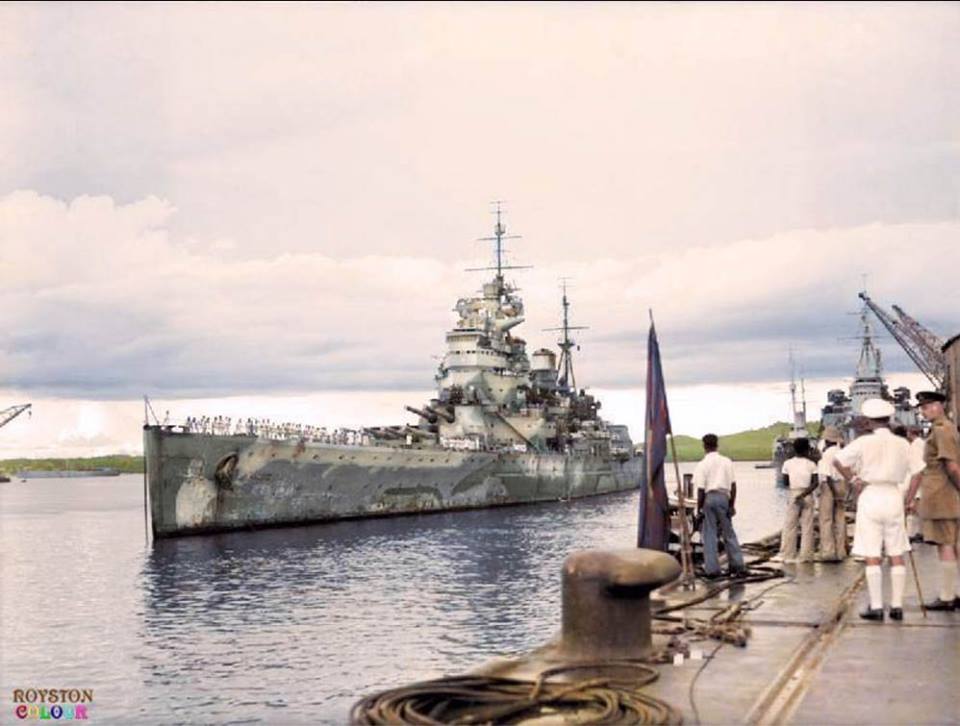@SuperbattleshipYamato Yeah I get you 100%. Alternate History is a niche interest in the first place so finding other people willing to go down the rabbit hole is always tough.
Dec 4
-

4 December 1941
HMS Prince of Wales arriving at Sembawang Naval Base, Singapore.
The King George V-class 14in gun Battleship was sunk by Japanese aircraft torpedoes six days later on 10 December 1941 with great loss of life .
December 8th, at 1735 hours Force Z comprising the PRINCE OF WALES (Flag CinC Eastern Fleet), REPULSE and the destroyers ELECTRA, EXPRESS, TENDOS and HMAS VAMPIRE sailed from the Sembawang naval dockyard, out into the South China Sea and set course to pass east of the Anamba Islands and thence northward.
December 10th at 1114 hours the PRINCE OF WALES opened fire on nine Japanese ‘Nell’ torpedo bombers, from the Genzan group, coming in to attack from port side. One attacker turned away to attack the REPULSE and the remaining eight dropped their torpedoes from ranges between 1650 and 650 yards and at a height of approximately 100 feet. Seven of the torpedoes were avoided but the eighth torpedo, which was a 45cm diameter Type 91 with a 150kg Type 97 warhead, struck her port quarter.
At 1144 hours the PRINCE OF WALES received, one torpedo hit on the port quarter. Following which she listed 11½ degrees to port and speed was reduced to 15 knots. The PRINCE OF WALES was never properly under control again. Five 5.25in turrets were put out of action. A second hit was reported at the time between turrets P3 and P4, but subsequent examinations of the wreck have disproved this. One aircraft was claimed shot down crashing into the sea on starboard side.At 1320 hours the PRINCE OF WALES sank capsizing to port, in position 3-33-36N, 104-28-42E. Out of her crew of 1612 men; 20 officers, 280 sailors and 27 marines were lost. Among the dead were Admiral Sir Tom Phillips, CinC of the Eastern Fleet, and the CO of the PRINCE OF WALES Captain John C. Leach.
The destroyers EXPRESS, ELECTRA and VAMPIRE picked up 90 officers and 1195 crew and marines, the majority being picked up by the EXPRESS. (www.naval-history.net)(Photo Source - IWM - A 6784)
-
@captain-walker
Nice photo. Thought it would look bigger.
Yea needed air suport. Anyway : ) -
Loved that write up; thanks Capt Walker.
-
The unlucky POW has the unfortunate distinction of being, as far as I know, the only British battleship which was involved in two famous and important naval actions of WWII, one against Germany and one against Japan, and of ending up on the losing end of both engagements (fatally so in the second case). On the more positive side, she was the venue for the August 1941 Churchill-Roosevelt summit in Newfoundland, which among other things resulted in the Atlantic Charter. The document would be called a “communique” today (when summit meetings are common events, and post-summit communiques are a routine element of such meetings), but back in 1941 this sort of thing was rather novel. The Atlantic Charter was referenced at various times during WWII, either pleasing or embarrassing Churchill depending on the circumstances (such as when he argued that the Charter article which expressed respect for “the right of all peoples to choose the form of government under which they will live” didn’t apply to British-rule India), and it ultimately helped to lay the foundations of the United Nations charter.






